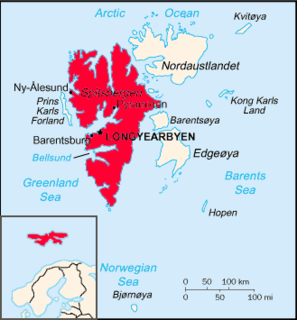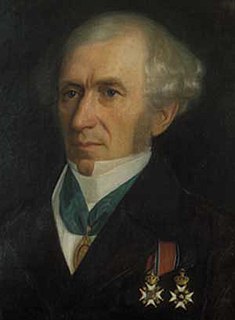
Svalbard, previously known as Spitsbergen, or Spitzbergen, is a Norwegian archipelago in the Arctic Ocean. Situated north of mainland Europe, it is about midway between the northern coast of Norway and the North Pole. The islands of the group range from 74° to 81° north latitude, and from 10° to 35° east longitude. The largest island is Spitsbergen, followed by Nordaustlandet and Edgeøya, and the largest settlement is Longyearbyen.

Svalbard is an archipelago in the Arctic Ocean roughly centered on 78° north latitude and 20° east longitude. The archipelago is the northernmost part of the Kingdom of Norway. The three main islands in the group consist of Spitsbergen, Nordaustlandet and Edgeøya. There are also a number of smaller islands, such as Barents Island (Barentsøya), Kvitøya, Prins Karls Forland, Kongsøya, Bear Island, Svenskøya, Wilhelm Island and other smaller islands or skerries.

Spitsbergen is the largest and only permanently populated island of the Svalbard archipelago in northern Norway.

This is a list of hospitals for each country in Europe.

Svalbard Airport, Longyear is the main airport serving Svalbard in Norway. It is 5 km (3.1 mi) northwest of Longyearbyen on the west coast, and is the northernmost airport in the world with scheduled public flights. The first airport near Longyearbyen was constructed during World War II. In 1959, it was first used for occasional flights, but could only be used a few months a year. Construction of the new airport at Hotellneset started in 1973, and the airport was opened on 2 September 1975. It is owned and operated by state-owned Avinor.

Prof Sven Ludvig Lovén, was a Swedish marine zoologist and malacologist. The Sven Loven Centre for Marine Sciences within the University of Gothenburg was named in his honour.

Ceresfjellet is a mountain on Spitsbergen in Svalbard, Norway. At 1,675 metres (5,495 ft) tall, it is the third-largest peak on Svalbard. It is located west of Wijdefjorden and is named for the dwarf planet Ceres.

Chadwickryggen is a mountain on Spitsbergen in Svalbard, Norway. At 1,640 metres (5,380 ft) high, it is the fourth-largest peak on Svalbard. It is located west of Wijdefjorden between Smutsbreen and Tryggvebreen in Ny-Friesland. It is named for the English physicist James Chadwick (1891–1974).

Galileotoppen is a mountain on Spitsbergen in Svalbard, Norway. At 1,637 metres (5,371 ft) tall, it is the fifth-tallest peak on Svalbard. It is located west of Wijdefjorden northwest of Newtontoppen in the south of Ny-Friesland. It is named for the Italian astronomer Galileo Galilei (1564–1642).

Operafjellet is a mountain on Spitsbergen in Svalbard, Norway. It is 968 metres (3,176 ft) tall and is located on the north side of Adventdalen. It is named for the amphitheatre-shape of the mountain on the western side, with the peak Tenoren sticking up. On 29 August 1996, it was the site for the crash of Vnukovo Airlines Flight 2801 during approach to Svalbard Airport, Longyear, killing 141 people.

Werner Werenskiold was a Norwegian geologist and geographer. He was a son of Erik Werenskiold and visual artist Sophie Marie Stoltenberg Thomesen (1849–1926), and the brother of Dagfin Werenskiold.

Balthazar Mathias Keilhau was a Norwegian geologist and mountain pioneer. He is regarded as the founder of the discipline of geology in Norway, and has also been credited for the discovery of the Jotunheimen mountain range.
Vengefjellet is a mountain in Nathorst Land at Spitsbergen, Svalbard. It has a height of 762 m.a.s.l., and is located west of the valley of Danzigdalen. The mountain is surrounded by the glaciers of Steindolpbreen and Snøkuvbreen to the south, and Vengebreen to the west and north.
Blæja is a mountain in Nathorst Land at Spitsbergen, Svalbard. It has a height of about 1,078 m.a.s.l. The mountain is surrounded by the glaciers of Kvamsisen, Steenstrupbreen and Svalbreen. Svalbreen extends from Blæja to the valley of Danzigdalen.
Kvitskarvbreen is a glacier in Nathorst Land at Spitsbergen, Svalbard. It has a length of about 8.5 kilometers, and extend northwestwards from the mountain of Kvitskarvet to the valley of Bromelldalen. The glaciers of Lundbreen, Juvbreen and Zimmerbreen are all tributaries to Kvitskarvbreen.
Martin Hoff Ekroll was a Norwegian merchant, mountaineer and Arctic explorer.

Wijkanderberget is a mountain in Wedel Jarlsberg Land at Spitsbergen, Svalbard.

Elisabeth Isaksson is a Swedish glaciologist and geologist who has researched polar climate history on the basis of ice cores. She has also studied snow and ice pollution on the Norwegian island of Svalbard and has participated in award-winning European projects on Antarctic climate change.

The wildlife of Norway includes the diverse flora and fauna of Norway. The native plants and animals are adapted to the geography and climate of this country in northwestern Europe. The habitats include high mountains, tundras, rivers, lakes, wetlands, sea coast and some lower cultivated land in the south. Mainland Norway has a long coastline, protected by skerries and much dissected by fjords, and the mostly-icebound archipelago of Svalbard lies further north. The flora is very varied and a large range of mammals, birds, fish and invertebrate species live here, as well as a few species of reptiles and amphibians.












